 Many real-world shortest path problems include constraints that classic algorithms don’t directly handle. NetworkX provides robust, optimized implementations of algorithms like Dijkstra’s, Bellman-Ford, and A*. But what if your problem doesn’t fit the classic shortest path formulation?
Read more...
Many real-world shortest path problems include constraints that classic algorithms don’t directly handle. NetworkX provides robust, optimized implementations of algorithms like Dijkstra’s, Bellman-Ford, and A*. But what if your problem doesn’t fit the classic shortest path formulation?
Read more...
 Many real-world shortest path problems include constraints that classic algorithms don’t directly handle. NetworkX provides robust, optimized implementations of algorithms like Dijkstra’s, Bellman-Ford, and A*. But what if your problem doesn’t fit the classic shortest path formulation?
Read more...
Many real-world shortest path problems include constraints that classic algorithms don’t directly handle. NetworkX provides robust, optimized implementations of algorithms like Dijkstra’s, Bellman-Ford, and A*. But what if your problem doesn’t fit the classic shortest path formulation?
Read more...
 PyPalettes is a new Python library designed to simplify the use of color palettes in Python charts.
Read more...
PyPalettes is a new Python library designed to simplify the use of color palettes in Python charts.
Read more...
 The 2024 Scientific Python Developer summit was held 3–5 June in Seattle. Here’s a summary of what we did.
Read more...
The 2024 Scientific Python Developer summit was held 3–5 June in Seattle. Here’s a summary of what we did.
Read more...
TL;DR: If you have GPU code in your project, setup a GitHub hosted GPU runner today. It is fairly quick to do and will free you from having to run tests manually.
Read more...Eighteen years since the release of NumPy 1.0, we are thrilled to announce the launch of NumPy 2.0! This major release marks a significant milestone in the evolution of NumPy, bringing a wealth of enhancements and improvements to users, and setting the stage for future feature development.
Read more...Given the practical challenges of achieving true randomness, deterministic algorithms, known as Pseudo Random Number Generators (RNGs), are employed in science to create sequences that mimic randomness. These generators are used for simulations, experiments, and analysis where it is essential to have numbers that appear unpredictable. I want to share here what I have learned about best practices with pseudo RNGs and especially the ones available in NumPy.
Read more...